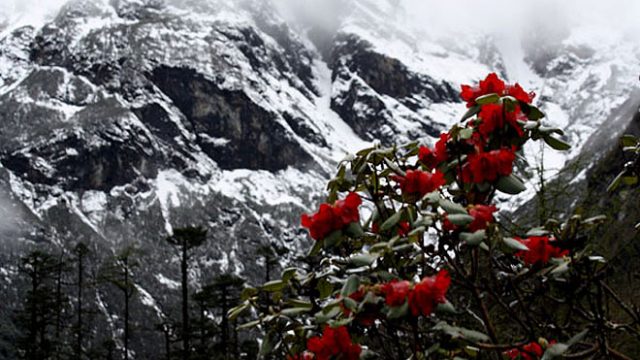Looking for the red panda, trying to photograph the elusive snow leopard, or hiking through a rhododendron forest when the flowers are in full bloom are a few of the activities that make Sikkim’s nature reserves such an exciting place.
Entry to all national parks and wildlife sanctuaries need prior permission from the state forest department.

Barsey Rhododendron Sanctuary: Located in west Sikkim, the Barsey (also Varsey) Rhododendron Sanctuary, is a trekker’s delight, especially in April-May when the colourful rhododendrons bloom. With five forest types present here, it forms an important corridor between the Khangchendzonga National Park of Sikkim and the Singalila National Park of West Bengal. The sanctuary can be approached through the villages of Hilley, Dentam and Soreng. Traditionally, Hilley is more popular entry point as you can drive up to here and then trek for 4km through pine forests to reach Barsey. Entry permits are available at Hilley on per head, per day basis. A variety of epiphytic orchids, ferns, mosses and lichens are also seen. The meadows at the higher levels are rich in medicinal plants. An important bird area (IBA), it is also home to leopard, barking deer, black bear, etc. Best time: April-May.

Fambong Lho Wildlife Sanctuary: Conveniently located, about 20km from Sikkim’s state capital Gangtok, the Fambong Lho Wildlife Sanctuary lies between Singtam and Dikchu. See if you can spot the red panda here. Other animals include barking deer, yellow-throated marten, takin, etc. The sanctuary is also home to a large number of birds and butterflies. You can go up to the Chuli hamlet (which has a trekker’s hut) located at the highest point of the sanctuary. The Khangchendzonga National Park lies to the west of the sanctuary.

Khangchendzonga (High Altitude) National Park: If you are a mountaineer or a high altitude trekker with interest in wildlife, North Sikkim’s Khangchendzonga National Park (KNP) is just for you. It has the Tent Peak and the Zemu Glacier Ridge on the north, the Lamaongden Mountain ridge on the east, Mount Narsing and Pandim on the south, and the majestic Khangchendzonga to the west. Thus protected, the KNP has evolved into a unique zone and is part of the Khangchendzonga Biosphere Reserve (KBR) and an IBA. The KNP is home to musk deer, snow leopard, Himalayan tahr, sloth bear, Himalayan black bear, red panda, etc. and to over 500 species of birds. Best time: April-May.Chungthang is the nearest town (about 100km from Gangtok). Indians need to obtain Inner Line Permit from the state Home department and foreigners need Restricted Area Permit from the Ministry of Home Affairs, Government of India, Delhi.
Kyongnosla Alpine Sanctuary: You are on the doorstep of the Kyongnosla Alpine Sanctuary when you are visiting the popular Chhangu Lake from Gangtok (en route to Nathu La). The sanctuary is well known for its flora and fauna. It may be a trifle difficult to locate the alpine meadow when the area is covered in snow. Rare and endangered ground orchids and rhododendrons interspersed among tall junipers and taller silver firs can be found here. Best time: April – August, October – November.

Maenam Wildlife Sanctuary: Located near one of south Sikkim’s popular tourist town, Rabongla, the sanctuary is named after the Maenam Peak (10,600 feet). The sanctuary straddles the Maenam – Tendong ridge and is drained by the Teesta and the Rangit rivers. There is a Buddhist monastery at the top of the ridge. The area is rich in medicinal plants (Maenam La means a Treasury of Medicines). Leopard, red panda, civet, orange-bellied Himalayan squirrel, black eagle are a few of the notable fauna found here. The open patches interspersed with dense forests shelters a large a number of birds. The sanctuary is one of the important IBAs of Sikkim. Some of the vulnerable species found here are the Red-breasted Hill Partridge, Blyth’s Tragopan, etc. Best time: March – late May, September – mid-December.
Singba Rhododendron Sanctuary: Located in the Yumthang valley of north Sikkim, the Singba Rhododendron Sanctuary breaks into a profusion of flowers in summer. The sanctuary is home to the endemic Rhododendron niveum, the state tree. Besides rhododendrons, you can also see other varieties of flowers such as primulas, potentillas, gentians, poppies and aconites, across the alpine meadow. There are also hot spring in the valley; a bathing hut has been constructed near two of the thermal springs. Lachung village, ahead of the Yumthang valley, is the best place to stay. According to environmentalists and wildlife experts, human intervention and tourism activity must be kept under control to save this vulnerable area. Best time: March – May, October – December.




